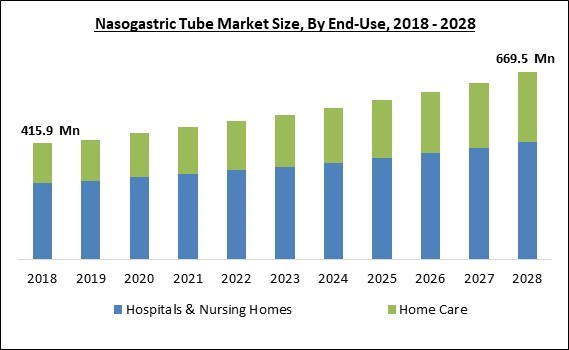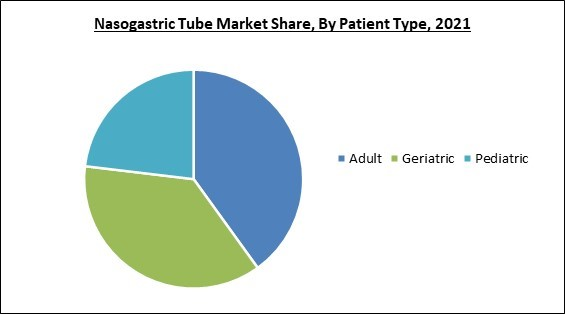The Global Nasogastric Tube Market size is expected to reach $669.5 Million by 2028, rising at a market growth of 5.2% CAGR during the forecast period.
A nasogastric (NG) tube is used to enter the stomach through the nose, nasopharynx, and throat. It is a tube made of plastic and elastic that has bidirectional potential and is flexible. These devices can provide enteral nutrition for up to six weeks. In addition, NG tubes are routinely used to provide medication and nourishment, add contrast to a stomach for X-rays, remove air or liquids from the stomach, and protect the bowel following surgery or during bowel rest.
Appropriate dietary intake is essential for overall health, wellness, and illness prevention. Often, nasogastric (NG) tubes are used to administer enteral nourishment and medications to infants, adults, and geriatric patients who have difficulty eating and digesting food and medication. In addition, essential nutrition and calories are restricted for prematurely born and ill infants. In these circumstances, nasogastric tubes deliver important dietary components and drugs.
The NG tube is guided into the nasal cavity to enter the stomach, bypassing the nasopharynx and esophagus. It is often made of rubber or plastic and is characterized by its flexibility & bidirectional potential. In addition, it is used to remove undesired stomach contents, deplete gastric chemicals, decompress the stomach, and remove poisonous semi-solids and liquids from the stomach. The NG tube allows access to the gastrointestinal system, which assists in treating bowel reconstruction and stomach immobility.
Increasing preterm births and a growing preference for enteral feeding are the primary reasons driving the expansion of the nasogastric tube market. In addition, infants born prematurely have a limited supply of vital nutrients and calories for sustaining metabolic activity; as a result, this becomes crucial to provide them with adequate nutrition and energy. Hence, the nasogastric tubes provide sufficient nutrition to prematurely born children, increasing the demand for these tubes in the market and positively affecting the market's growth in the coming years.
The market research report covers the analysis of key stake holders of the market. Key companies profiled in the report include Becton, Dickinson and Company, Medtronic PLC, Cardinal Health, Inc., QMD, Angiplast Pvt. Ltd., Securmed Spa, Vygon SAS, Andersen Products, Inc. (Weiler Abrasives Group), Guangdong Baihe Medical Technology Co., Ltd. and Poly Medicure Ltd.
A nasogastric (NG) tube is used to enter the stomach through the nose, nasopharynx, and throat. It is a tube made of plastic and elastic that has bidirectional potential and is flexible. These devices can provide enteral nutrition for up to six weeks. In addition, NG tubes are routinely used to provide medication and nourishment, add contrast to a stomach for X-rays, remove air or liquids from the stomach, and protect the bowel following surgery or during bowel rest.
Appropriate dietary intake is essential for overall health, wellness, and illness prevention. Often, nasogastric (NG) tubes are used to administer enteral nourishment and medications to infants, adults, and geriatric patients who have difficulty eating and digesting food and medication. In addition, essential nutrition and calories are restricted for prematurely born and ill infants. In these circumstances, nasogastric tubes deliver important dietary components and drugs.
The NG tube is guided into the nasal cavity to enter the stomach, bypassing the nasopharynx and esophagus. It is often made of rubber or plastic and is characterized by its flexibility & bidirectional potential. In addition, it is used to remove undesired stomach contents, deplete gastric chemicals, decompress the stomach, and remove poisonous semi-solids and liquids from the stomach. The NG tube allows access to the gastrointestinal system, which assists in treating bowel reconstruction and stomach immobility.
Increasing preterm births and a growing preference for enteral feeding are the primary reasons driving the expansion of the nasogastric tube market. In addition, infants born prematurely have a limited supply of vital nutrients and calories for sustaining metabolic activity; as a result, this becomes crucial to provide them with adequate nutrition and energy. Hence, the nasogastric tubes provide sufficient nutrition to prematurely born children, increasing the demand for these tubes in the market and positively affecting the market's growth in the coming years.
COVID-19 Impact Analysis
The shift in emphasis within the medical sector towards COVID-19 treatment has reduced financing for research and development activities relating to enteral nutrition. In addition, the number of patients admitted to intensive care units (ICUs) continued to rise throughout the pandemic. During the pandemic, there was a discernible rise in the number of COVID-19 patients who required nasojejunal and nasogastric tubes. Because of this, the nasogastric tube market was able to grow significantly during the pandemic period.Market Growth Factors
Growing occurrence of premature births
Prematurity is the biggest cause of death among children under five worldwide. WHO estimates that over 15 million babies are prematurely born each year. This is more than one in every ten children. Around one million children die annually owing to problems associated with preterm birth. Several survivors face a lifetime of handicaps, including learning disorders and vision and hearing issues. Infants may be born prematurely due to spontaneous preterm labor or a medical indication to schedule an early inducement of labor or cesarean birth. Thus, the rising occurrence of preterm birthswill contribute to the growth of the market for nasogastric tubes.Growing life expectancy and geriatric population
Life expectancy is increasing. Most of the individuals today can expect to live well into their sixties and beyond. Every nation in the globe is observing an increase in the number and proportion of its elderly population. One in six individuals will be 60 or older by the year 2030. The percentage of the world's population aged 60 and over will rise from 1 billion in 2020 to 1.4 billion in 2050. By 2050, the global population aged 60 and over will have doubled (2.1 billion). The number of people aged 80 and older is projected to treble between 2020 and 2050, reaching 426 million by 2050. These factors are contributing to the growth of the market.Market Restraining Factors
Certain complications associated with NG tubes
If the tube becomes clogged or fails and cannot decompress the stomach, it may increase the risk of aspiration due to the stenting effect. Long-term NG tube use can irritate the gastric lining, resulting in gastrointestinal hemorrhage. Electrolyte problems, such as hypokalemia, can arise in patients undergoing extensive NG tube irrigation. Persistent pressure on one part of the nare might result in nasal pressure ulcers or necrosis. Due to these issues of a nasogastric tube, patients, as well as healthcare providers, may not prefer inserting nasogastric tubes, which may result in hampering the market growth.Patient Type Outlook
Based on patient type, the nasogastric tube market is segmented into adult, pediatric and geriatric. The pediatric segment covered a considerable revenue share in the nasogastric tube market in 2021. Infants who are unwell or premature may be unable to breastfeed or suck from a bottle well enough. The nasogastric tube can provide all or some of the baby's nutrition. This strategy is the most efficient and safest way to provide a nutritious diet. Oral medication can also be given through the tube.Indication Outlook
By indication, the nasogastric tube market is categorized into stomach cancer, esophageal cancer, IBD, chronic kidney disease, dysphagia and others. The esophageal cancer segment recorded a remarkable revenue share in the nasogastric tube market in 2021. Cancer, known as esophageal cancer, affects the esophagus cells, the muscular tube that transports food and liquids from the throat to the stomach. The primary factor fueling the segment's expansion is the rising incidence of chronic esophageal inflammation that may be brought on by gastroesophageal reflux disease (GERD).Type Outlook
On the basis of type, the nasogastric tube market is divided into small-bore feeding tubes, and large-bore feeding tubes. The large-bore feeding tubes segment garnered a significant revenue share in the nasogastric tube market in 2021. Large-bore feeding tubes may be employed for feeding or giving medication, but their principal purposes are gastric suctioning or decompression. Another purpose of a large-bore nasogastric tube is to measure stomach pH or residual volume.End-use Outlook
Based on end-use, the nasogastric tube market is bifurcated into hospitals & nursing homes and home care. The hospital & nursing home segment registered the maximum revenue share in the nasogastric tube market in 2021. The increasing frequency of ingesting and gastrointestinal problems among an older population is the primary factor driving the hospital sector. When this occurs, supplemental nutrients must be administered via the nasogastric channel, which reduces the need for nasogastric tube feeding.Regional Outlook
Region wise, the nasogastric tube market is analyzed across North America, Europe, Asia Pacific and LAMEA. In 2021, the North America region led the nasogastric tube market by generating the highest revenue share. This development is attributable to factors like the expanding number of critical care units and the ageing population in nations such as the United States, Canada, and Mexico. Furthermore, the increasing incidence of obesity & digestive problems is one of the most important reasons for the increase in demand. In addition, R&D efforts associated with NG tube products are anticipated to rise during the forecast period.The market research report covers the analysis of key stake holders of the market. Key companies profiled in the report include Becton, Dickinson and Company, Medtronic PLC, Cardinal Health, Inc., QMD, Angiplast Pvt. Ltd., Securmed Spa, Vygon SAS, Andersen Products, Inc. (Weiler Abrasives Group), Guangdong Baihe Medical Technology Co., Ltd. and Poly Medicure Ltd.
Scope of the Study
By Indication
- Dysphagia
- Chronic Kidney Disease
- Inflammatory Bowel Disease (IBD)
- Esophageal Cancer
- Stomach Cancer
- Others
By Patient Type
- Adult
- Geriatric
- Pediatric
By Type
- Small-bore Feeding Tubes
- Large-bore Feeding Tubes
By End-Use
- Hospitals & Nursing Homes
- Home Care
By Geography
- North America
- US
- Canada
- Mexico
- Rest of North America
- Europe
- Germany
- UK
- France
- Russia
- Spain
- Italy
- Rest of Europe
- Asia Pacific
- China
- Japan
- India
- South Korea
- Singapore
- Malaysia
- Rest of Asia Pacific
- LAMEA
- Brazil
- Argentina
- UAE
- Saudi Arabia
- South Africa
- Nigeria
- Rest of LAMEA
Key Market Players
List of Companies Profiled in the Report:
- Becton, Dickinson and Company
- Medtronic PLC
- Cardinal Health, Inc.
- QMD
- Angiplast Pvt. Ltd.
- Securmed Spa
- Vygon SAS
- Andersen Products, Inc. (Weiler Abrasives Group)
- Guangdong Baihe Medical Technology Co., Ltd.
- Poly Medicure Ltd.
Unique Offerings
- Exhaustive coverage
- The highest number of Market tables and figures
- Subscription-based model available
- Guaranteed best price
- Assured post sales research support with 10% customization free
Table of Contents
Chapter 1. Market Scope & Methodology
Chapter 2. Market Overview
Chapter 3. Global Nasogastric Tube Market by Indication
Chapter 4. Global Nasogastric Tube Market by Patient Type
Chapter 5. Global Nasogastric Tube Market by Type
Chapter 6. Global Nasogastric Tube Market by End-Use
Chapter 7. Global Nasogastric Tube Market by Region
Chapter 8. Company Profiles
Companies Mentioned
- Becton, Dickinson and Company
- Medtronic PLC
- Cardinal Health, Inc.
- QMD
- Angiplast Pvt. Ltd.
- Securmed Spa
- Vygon SAS
- Andersen Products, Inc. (Weiler Abrasives Group)
- Guangdong Baihe Medical Technology Co., Ltd.
- Poly Medicure Ltd.










